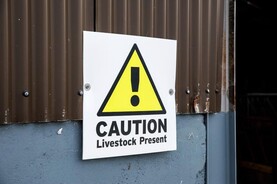Cow temperament can quickly change during labour and immediately after calving as the animal’s maternal instinct kicks in.Do not take cow behaviour for granted. Cows may be docile most days, but a sudden change in temperament when calving is possible and catches farmers off guard, resulting in accidents.
Cow temperament can quickly change during labour and immediately after calving as the animal’s maternal instinct kicks in.
Do not take cow behaviour for granted. Cows may be docile most days, but a sudden change in temperament when calving is possible and catches farmers off guard, resulting in accidents.
Keep safety in mind at calving time, especially when other family members are helping out. Outlined are some safety tips for calving time.
1. Locking cows in a proper calving gate
A proper calving gate with a headlock and side access is a must for every farm. As the gate securely restrains the cow, it makes assisting during labour much safer.
Do not try to calve cows in a crush race or behind a gate. You are just asking for trouble and the risk of serious injury increases.
With the cow secured in the headlock, you can safely work to resuscitate a newborn calf, assist with feeding or ear tagging. Only release the cow from the headlock once you have exited the pen.
2. Moving cows and calves
Once calved, cows can be very protective of their newborn progeny. Moving cows and calves from the calving pen back to a group or loose pen can pose a risk of injury.
Having a well-designed unit helps with moving animals safely between sheds, especially when working on your own.
The challenge comes when sheds are not side by side and the cow and calf have to cross a yard with open spaces.
As calves can be slow to move, cows can become aggressive if they lose sight of their newborn as it lags behind. In open space, there are few options to escape if the cow does decide to charge.
In such scenarios, moving cows in a trailer may be a safer option or simply delay movement until there is help available.
When you are moving animals, the key thing is trying to avoid getting between the cow and calf, as, again, this breaks the line of sight and the cow may see you as a threat.
3. Have two escape points in a calving pen
When it is necessary to enter a calving pen, it is vital there are at least two exit points, ideally on opposite sides to each other.
With one exit, if the cow stands between you and an escape point, the risk of serious or fatal injury is massive.
Whereas, if there are two escape points in the pen, the cow cannot block both exits and there is a greater chance of escaping unharmed.
4. Never turn you back on a freshly calved cow
When checking on a newborn calf and the cow is not restrained, always move slowly and calmly. Sudden movements will spook the cow.
Once you reach the calf, always work facing the cow. Never turn your back on a freshly calved cow. If possible, slowly pull the calf towards an escape point so you can exit if the cow does charge.
5. Keep dogs away from the calving shed
Cows will also view dogs as a threat to their calf, so keep them well away from calving sheds and loose housing where freshly calved cows are housed.
Read more
As much as €275/head difference between top and bottom paying factory in 2024
Five basics to include in calving kit





SHARING OPTIONS: